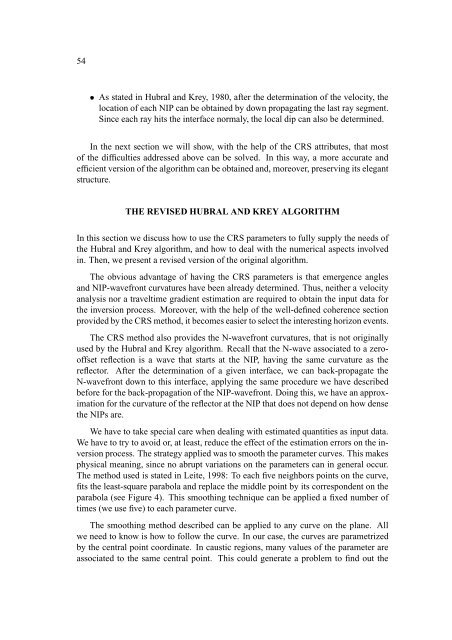Annual Report 2000 - WIT
Annual Report 2000 - WIT
Annual Report 2000 - WIT
Create successful ePaper yourself
Turn your PDF publications into a flip-book with our unique Google optimized e-Paper software.
54<br />
As stated in Hubral and Krey, 1980, after the determination of the velocity, the<br />
location of each NIP can be obtained by down propagating the last ray segment.<br />
Since each ray hits the interface normaly, the local dip can also be determined.<br />
In the next section we will show, with the help of the CRS attributes, that most<br />
of the difficulties addressed above can be solved. In this way, a more accurate and<br />
efficient version of the algorithm can be obtained and, moreover, preserving its elegant<br />
structure.<br />
THE REVISED HUBRAL AND KREY ALGORITHM<br />
In this section we discuss how to use the CRS parameters to fully supply the needs of<br />
the Hubral and Krey algorithm, and how to deal with the numerical aspects involved<br />
in. Then, we present a revised version of the original algorithm.<br />
The obvious advantage of having the CRS parameters is that emergence angles<br />
and NIP-wavefront curvatures have been already determined. Thus, neither a velocity<br />
analysis nor a traveltime gradient estimation are required to obtain the input data for<br />
the inversion process. Moreover, with the help of the well-defined coherence section<br />
provided by the CRS method, it becomes easier to select the interesting horizon events.<br />
The CRS method also provides the N-wavefront curvatures, that is not originally<br />
used by the Hubral and Krey algorithm. Recall that the N-wave associated to a zerooffset<br />
reflection is a wave that starts at the NIP, having the same curvature as the<br />
reflector. After the determination of a given interface, we can back-propagate the<br />
N-wavefront down to this interface, applying the same procedure we have described<br />
before for the back-propagation of the NIP-wavefront. Doing this, we have an approximation<br />
for the curvature of the reflector at the NIP that does not depend on how dense<br />
the NIPs are.<br />
We have to take special care when dealing with estimated quantities as input data.<br />
We have to try to avoid or, at least, reduce the effect of the estimation errors on the inversion<br />
process. The strategy applied was to smooth the parameter curves. This makes<br />
physical meaning, since no abrupt variations on the parameters can in general occur.<br />
The method used is stated in Leite, 1998: To each five neighbors points on the curve,<br />
fits the least-square parabola and replace the middle point by its correspondent on the<br />
parabola (see Figure 4). This smoothing technique can be applied a fixed number of<br />
times (we use five) to each parameter curve.<br />
The smoothing method described can be applied to any curve on the plane. All<br />
we need to know is how to follow the curve. In our case, the curves are parametrized<br />
by the central point coordinate. In caustic regions, many values of the parameter are<br />
associated to the same central point. This could generate a problem to find out the







